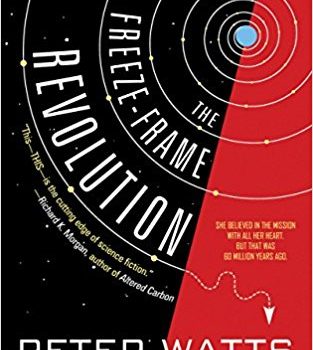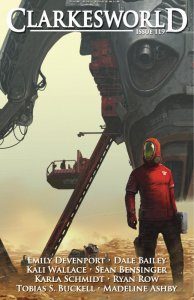Russell Letson reviews The Freeze-Frame Revolution by Peter Watts
 The Freeze-Frame Revolution, Peter Watts (Tachyon Publications 978-1-61696-252-4, $14.95, 190pp, tp) June 2018. Cover by Elizabeth Story.
The Freeze-Frame Revolution, Peter Watts (Tachyon Publications 978-1-61696-252-4, $14.95, 190pp, tp) June 2018. Cover by Elizabeth Story.
Whether it’s a novella or a short novel (it’s the latter, by a margin of a thousand words, per a note in the author’s Acknowledgments), Peter Watts’s The Freeze-Frame Revolution is a remarkably compressed and elliptical tale. It belongs to a series that began with the Hugo-winning novelette “The Island” (2009) and continued, in back-and-forth narrative sequence, with “Hotshot” and “Giants” (both 2014). (The earlier stories are available on Watts’s website under Creative Commons licensing.) The four together would seem to be sections of, or perhaps companions to, a larger work-in-progress with the overall title Sunflowers, which at the moment remains somewhere over the horizon, according to Watts’s website.
But here we have the stand-alone short novel (or novella), so back to “compressed and elliptical,” particularly for readers not familiar with the earlier stories. It’s not that the necessary background information isn’t there – it is, starting with a front-matter diagram of the good ship Eriophora, which is also helpfully labeled as a United Nations Diaspora Authority vessel. Infodumps are few and cunningly distributed, though, and some vocabulary items remain unexplained (though understandable in context), so this is one of those SF texts that requires close attention to everything as it flies by. The basics: the Eriophora is an asteroid transformed into a sub-lightspeed starship, designed for a special and far-sighted mission – to seed the galaxy with wormhole gates that will provide faster-than-light travel to humankind – or maybe, given the condition of the Earth when the Eri is launched in the 23rd century, to humankind’s descendants. It carries a crew of 30,000, but no more than a handful are ever awakened from hibernation at any one time, and even then only rarely, to function as troubleshooters for the AI (AKA the Chimp) that runs the ship and oversees the mostly automated gate-building process.
The gates are built by robotic assemblers sent ahead of the ship, and the wormhole mouth is activated as the Eriophora accelerates back to its customary 20% of lightspeed, fleeing not only the storm of radiation that accompanies the wormhole’s creation, but the exotic and occasionally hostile monstrosities that sometimes pop out of the newly opened gate – “gremlins” that might be the very distant descendants of humankind, or some unrelated creatures that have discovered the interstellar four-lane.
As the story opens 66 million years into the mission, the narrator, Sunday Ahzmundin, like the rest of the crew, has hardly aged at all, thanks to the thin slices of time for which she has been awake. That enormous gulf of years leaves some of her crewmates with a much-diminished sense of purpose. They also feel straitjacketed by the original mission plan as installed in and governed by the Chimp, which, while deliberately dumbed-down for an AI, is still a formidable overseer, possessing raw computational power, an unfailing memory, panopticon senses, and the ability to tirelessly churn through scenarios. As Sunday puts it,
How do you plot against an enemy that never sleeps, that has all those empty ages to grind its brute-force way down every avenue, stumble across every careless clue you might have left behind? An enemy with eyes that span your whole world, an enemy that can see through your eyes…?
For those crew members who aspire to independence from the long-dead hand of Mission Control, breaking the Chimp’s hold and gaining a degree of freedom requires ingenuity and guile: mapping off-limits or unknown parts of the ship; finding locations where the Chimp cannot see and hear; devising methods of communication that span irregular waking periods and unpredictable combinations of personnel. The mutiny (which comes across as something more like a POW-camp escape) becomes a competition of feints and masquerades and fake-outs within fake-outs, of coded messages camouflaged as graffiti or games or musical compositions or jokes, of secret hiding places, of (almost literal) endless patience as long-game plans unwind.
An underlying issue is not just freedom – getting out of the system of elaborate, multi-layered, multiply redundant, all-contingencies planning that Mission Control devised – but free will. The crew was not recruited but made – bred, educated, conditioned, and neurologically optimized to suit the mission’s needs and requirements. Everywhere there is the sense that the Chimp and the mission and even the lives of the crew are governed by the mechanics of cost-benefit ratios, the mathematics of probability and endless calculations and what-ifs and backup protocols. At first Sunday has some hope that the Chimp is not as much an automaton, not as constrained as it is supposed to be. She talks to it in ways that her crewmates do not, and she remembers a time in its development when it seemed to play in a way that suggested a degree of freedom – until it hit some limit in its growth and became “a happy stunted being who didn’t know or care that it had once been blazing toward transcendence before some soulless mission priority stuck him in amber.” This is projection, of course – Sunday has had her own moments of rebellion, of trying to change the trajectory of the life she was designed for.
The story line, like Sunday’s lifeline, is discontinuous, fragmented into periods of awakening required by problems with gate building, and it offers views of cosmic machineries and glimpses of far, far futures that the crew will only ever see in tiny, contextless fragments. Whether or not the glimpses afforded to us readers will finally be expanded to fit together into a greater whole (as the other “Sunflower” pieces imply), this large fragment – part thriller, part hard-SF vision, part existential nightmare – is an impressive and intriguing exercise in fitting huge ideas into a small space.
This review and more like it in the June 2018 issue of Locus.
 While you are here, please take a moment to support Locus with a one-time or recurring donation. We rely on reader donations to keep the magazine and site going, and would like to keep the site paywall free, but WE NEED YOUR FINANCIAL SUPPORT to continue quality coverage of the science fiction and fantasy field.
While you are here, please take a moment to support Locus with a one-time or recurring donation. We rely on reader donations to keep the magazine and site going, and would like to keep the site paywall free, but WE NEED YOUR FINANCIAL SUPPORT to continue quality coverage of the science fiction and fantasy field.







